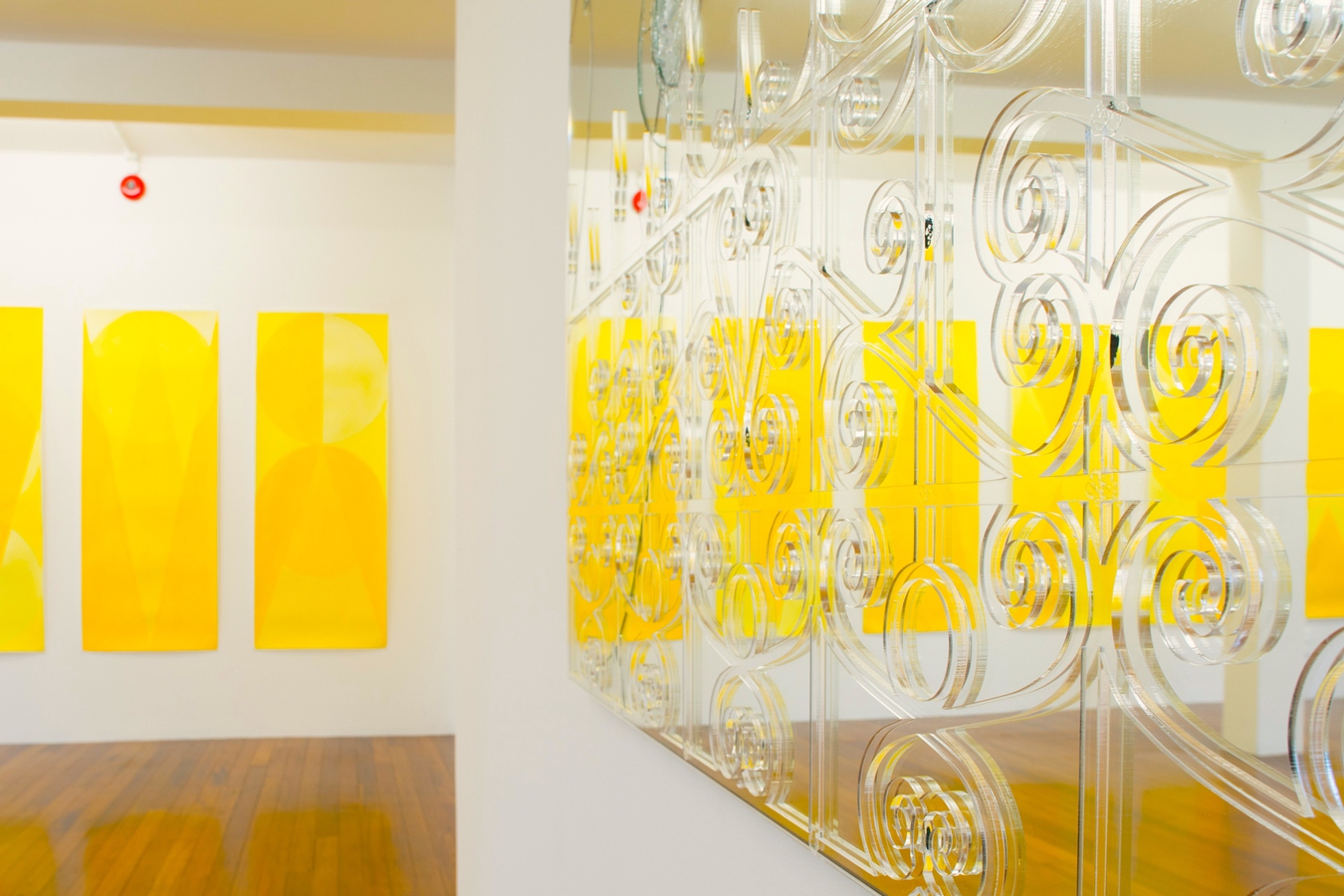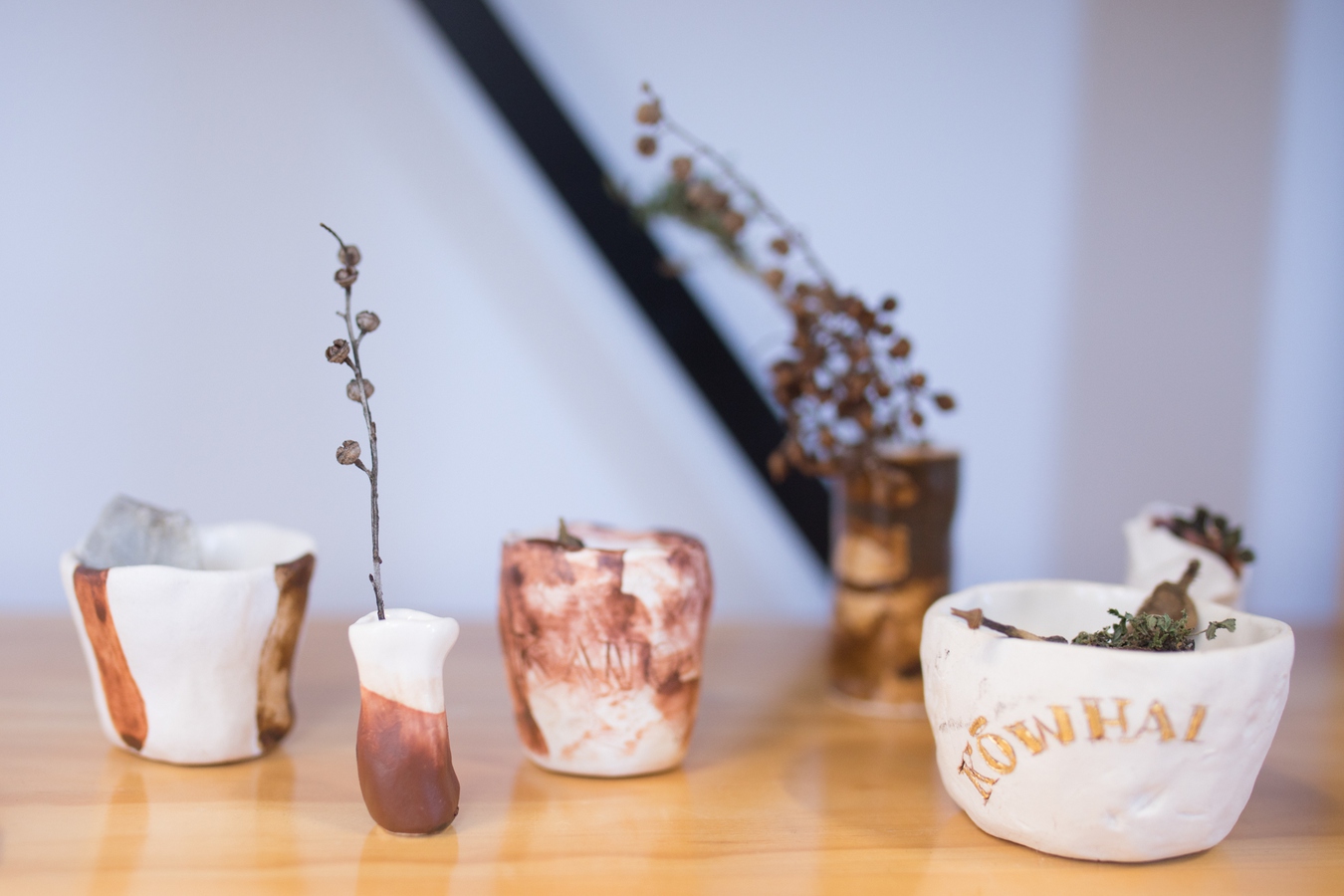Aroha Novak, Sriwhana Spong and George Watson
Like a broth, like a cure
31 May — 14 Jul 2024
Like a broth, like a cure
Aroha Novak, Sriwhana Spong and George Watson
Whakatau and exhibition opening: Friday 31 May, 5:30pm
Exhibition runs: 1 June – 14 July 2024
Like a broth, like a cure is about illness and remedy, grief and restoration as forms of inheritance. Works by Aroha Novak, Sriwhana Spong and George Watson each contend with historical narratives or structures that invite continual research , and knowledge that may be difficult to reconcile. The exhibition proposes that wellness involves both an engagement with the heaviness of specific colonial histories, and finding ways to revitalise ourselves in the present.
Aroha Novak’s installation MAURI-FY (2024) occupies the front of the gallery, and is made from materials found in the artist’s studio and garden, on hīkoi, and through friends and whanaunga. Entered through a floor-to-ceiling textile embroidered with kawakawa, the installation is intended as a space for mauri enhancement. In this space you might rest, have a kapu tī, read and learn more about the use of indigenous plants—particularly for fragrance—that have been an experimental part of Novak’s recent practice. This work stems from an earlier Ōtautahi based project where the artist focused on 88 indigenous and endemic plants, including sweet-smelling and medicinal mokimoki, taramea and piripiri, which were collected from this area as part of the colonising project. Novak’s research is founded in conversation, hands-on trial and error, and mātauranga tīpuna, the latter often accessed through reading the recordings of colonial ethnologists such as James Herries Beattie.
Sriwhana Spong’s Sigil (Rothschild’s mynah) (2017) is a series of large watercolours in clear yellow. The work refers to Rothschild’s mynah (jalek Bali), a critically endangered bird indigenous to Bali named after the British ornithologist Lord Walter Rothschild who financed the collecting of the species. The sigils, geometric symbols with magic capability, vividly assert the presence of non-scientific knowledge traditions, and perhaps their power to counter dominant taxonomies or even species’ loss. The exhibition’s title comes from a second work, Spong’s This Creature (2016). This video hinges on the artist’s desire to hold and read The Book of Margery Kempe (1436-38). The Kempe text, in which the author refers to herself as ‘this creature’, is considered to be the first autobiography in the English language. It is an account of a 15th-century mystic whose spirituality manifested in uncontrollable floods of tears. In the work extracts from this text are mixed with the artist’s sensory observations: a yearning to taste inedible things, footage of birds, and of her hand tracing sculptural and architectural forms in Hyde Park in London.
George Watson’s Disavow (2024) is the latest in a series of sculptures which reflect an interest in the built architecture of early settler colonialism, and the weight of this legacy for Māori, their land and for the artist’s own identity. Specifically, the ornate Victorian era wrought iron gate from which Disavow’s form comes invokes the lifestyle aspirations of 20th century Pākehā settlement in Aotearoa, and as such, the stealing and privatisation of Māori land. The gate is a structure for allowing entrance, or, for keeping people out. In this work paired curlicues in the centre of the translucent acrylic structure could be read as a heart shape, while the spiky finials along the top edge are designed to repel. However, Disavow is also a mirror, so that what is notionally held back or controlled—the world and weather outside, te taiao, visitors to the space—actually crosses that threshold with the entry of light itself.
Though distinct, these works share common ground in their understanding that inherited stories may involve pain or loss, and as such, ask us to consider what it is to heal or make change. The exhibition space is configured partly in response to the cold low-lit winter period, prioritising natural light and physical comfort. While each of these works engage with particular and complex knowledge systems on their own terms, collectively, may they act on us like a broth or a cure.
—
Aroha Novak (Ngāi Te Rangi, Ngāti Kahungunu, Tūhoe) is a multi-disciplinary artist living and working in Ōtepoti Dunedin. Novak completed her undergraduate degree in sculpture at Dunedin School of Art in 2007, and an MFA in 2013, also at Dunedin School of Art, Otago Polytechnic, Te Kura Matatini ki Otago. Her projects are often research based, drawing out indigenous and local histories that have been forgotten or suppressed. Novak frequently works outside of a conventional gallery context, collaborating with other artists, experts and communities to expand knowledge systems. Recent projects include He Kukupa, public artworks and te reo map at Tunnel Beach walking track, Ōtepoti Dunedin, 2024; Ihirangaranga/Resonances of the Forest:Toi taiao Whakatairanga (group exhibition), Te Uru Waitākere Contemporary Art Gallery, Titirangi, Tāmaki Makaurau Auckland, 2023; Iowerā: Kahre Hau Marangai, acollaboration with Georgina May Young, Hoea Gallery, Tairāwhiti Gisborne, 2023.
Sriwhana Spong’s practice moves between film, painting, performance and sculpture, and explores modes of following (how to approach a subject) and framing (how to understand it). Her works are often sparked by an encounter; most recently, a rat nesting outside her bedroom window; a newly discovered species of snake; a painting by her grandfather, the Balinese painter, I Gusti Made Rundu; and a twelfth-century Javanese poem. The traces of these encounters are filtered through processes of (un)knowing—experiential, scientific—in order to critically examine her own position, and how this might contribute to a collective and feminist understanding of an entangled cosmos. Spong graduated with a BFA from Elam School of Fine Arts, The University of Auckland Waipapa Taumata Rau in 2001, and an MFA from the Piet Zwart Institute, Rotterdam in 2015. Her work has been included in group exhibitions including the 17th Istanbul Biennial, 2022; trust & confusion, Tai Kwun Contemporary, Hong Kong, 2022; and Honestly Speaking: The Word, The Body, and The Internet, Auckland Art Gallery Toi o Tāmaki, Auckland, 2020. Solo exhibitions include Luzpomphia, Michael Lett, Tāmaki Makaurau Auckland, 2023; Ida-Ida, Spike Island, Bristol, 2019; A hook but no fish, Govett-Brewster Art Gallery, Ngāmotu New Plymouth, 2018. She lives in London.
George Watson is an artist living in Tūranganui-a-Kiwa, with Ngāti Porou and Ngāti Mutunga whakapapa and Moriori hokopapa. Watson graduated with a MFA from Elam School of Fine Arts, The University of Auckland Waipapa Taumata Rau in 2016, and was awarded funding to complete the Maumaus Independent Study Programme in Lisbon, Portugal in 2019. She has a Bachelor of Media Arts (majoring in painting and sculpture) from Waikato Institute of Technology, and an honours degree in art history from The University Auckland. Recent exhibitions include Hau Whakatonu, Govett-Brewster, Ngāmotu New Plymouth, 2023; Beauty Incarnate, City Gallery Wellington, Te Whanganui-a-Tara Wellington, 2023; He Rāwaho, with Peter Simpson, Coastal Signs, Tāmaki Makaurau Auckland, 2023; and Filial, Envy6011, Te Whanganui-a-Tara Wellington, 2022.
This exhibition is part of the Chartwell 50th Anniversary Project 2024, with a loan from the Chartwell Collection, Auckland Art Gallery Toi o Tāmaki.





















